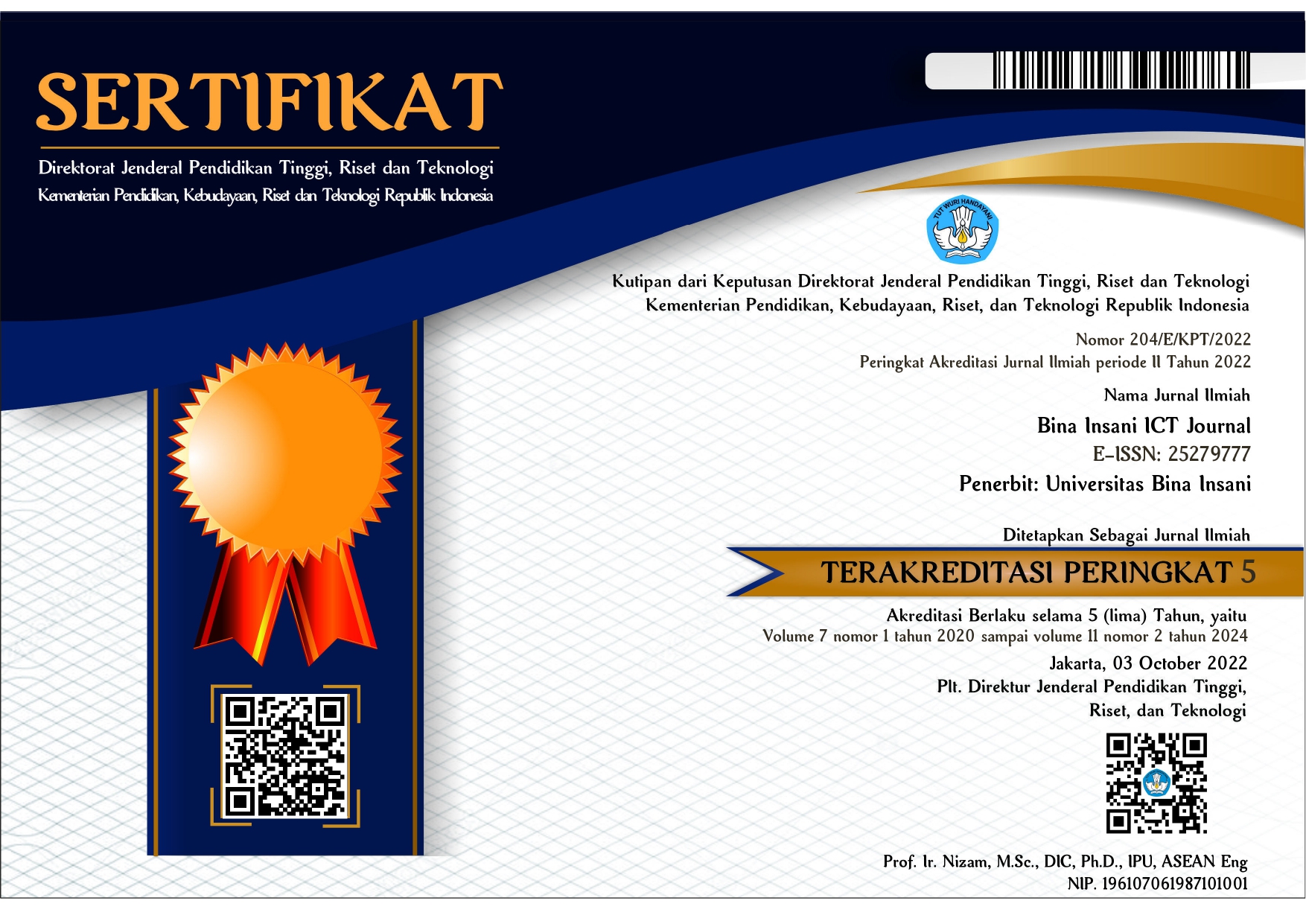Segmentasi Wilayah Terdampak Pandemi Covid-19 Berdasarkan Suhu Dan Kelembaban
Abstract
Berdasarkan proporsi antara jumlah orang yang terinfeksi dan jumlah kematian COVID-19, Indonesia yang menempati urutan kedua setelah Italia memiliki 1.285 infeksi dengan 114 kematian, yaitu 11,2%, maka perlu dikaji karakteristik penyebaran COVID-19 di wilayah ini. Pada penelitian ini akan menerapkan algoritma hierarki untuk menguji sejauh mana hasil cluster yang diperoleh untuk menunjukkan segmentasi wilayah terdampak pandemi yang dihubungkan dengan faktor suhu dan kelembaban udara. Dari proses clustering yang telah dilakukan, dengan membatasi pembentukan cluster sejumlah 3 buah, maka diperoleh pada cluster pertama terdapat 15 propinsi, pada cluster kedua terdapat 16 propinsi, dan pada cluster ketiga mempunyai 3 propinsi. Untuk atribut Terkonfirmasi, cluster 1 mempunyai nilai sebesar 8830.6, pada cluster 2 sebesar 6463.2, dan cluster 3 sebesar 70179. Untuk atribut Suhu, cluster 1 mempunyai nilai 26.7, cluster 2 mempunyai nilai 27.5, dan cluster 3 mempunyai nilai 28.3. Untuk atribut Kecepatan Angin secara berurutan cluster 1, cluster 2, dan cluster 3 mempunyai nilai masing - masing adalah 2, 2.7, dan 2.8. Dan untuk atribut Kelembaban mempunyai nilai masing - masing 82.6, 77.9, dan 73.1. Berdasarkan hasil uji tersebut, maka profiling cluster yang dapat disimpulkan adalah, kejadian atau kasus covid-19 berbanding lurus dengan suhu dan kecepatan angin namun berbanding terbalik dengan kelembaban udara, semakin tinggi angka kasus covid-19 maka terjadi pada propinsi dengan suhu dan kecepatan angin tinggi, akan tetapi berbanding terbalik dengan tingkat kelembaban udara.References
[1] WHO, "Coronavirus disease (COVID-19) weekly epidemiological update and weekly operational update," 2020. [Online]. Available: https://www.who.int/emergencies/diseases/novel-coronavirus-2019/situation-reports.
[2] E. Gralinski and V. Menachery, Return of the coronavirus: 2019-ncov, 2020.
[3] C. Huang, Y. Wang, X. Li, L. Ren, J. Zhao, Y. Hu, L. Zhang, G. Fan, J. Xu, X. Gu, Z. Cheng, T. Yu, J. Xia, Y. Wei, W. Wu, X. Xie, W. Yin, H. Li, M. Liu, Y. Xiao, H. Gao, L. Guo, J. Xie, G. Wang, R. Jiang, Z. Gao, Q. Jin, J. Wang and B. Cao, "Clinical features of patients infected with 2019 novel coronavirus in Wuhan, China," Lancet, pp. 497-506, 2020.
[4] P. Zhou, X. Yang, X. Wang, B. Hu, L. Zhang, W. Zhang, H. Si, Y. Zhu, B. Li, C. Huang, H. Chen, J. Chen, Y. Luo, H. Guo, R. Jiang, M. Liu, Y. Chen, X. Shen, X. Wang, X. Zheng, K. Zhao, Q. Chen, F. Deng, L. Liu, B. Yan, F. Zhan, Y. Wang, G. Xiao and Z. Shi, "A pneumonia outbreak associated with a new coronavirus of probable bat origin," Nature, p. 270, 2020.
[5] D. Xu, Z. Zhang, F. Chu, Y. Li, L. Jin, L. Zhang, G. Gao and F. Wang, "Genetic Variation of SARS Coronavirus in Beijing Hospital," Emerging Infectious Diseases, pp. 789-794, 2004.
[6] K. Chan, J. MalikPeiris, S. Lam, L. Poon, K. Yuen and W. Seto, "The effects of temperature and relative humidity on the viability of the SARS coronavirus," Advances in Virology, pp. 1-7, 2011.
[7] M. Darnell, K. Subbarao, S. Feinstone and D. Taylor, "Inactivation of the coronavirus that induces severe acute respiratory syndrome, SARS-CoV," Journal of Virological Methods, pp. 85-91, 2004.
[8] M. Ijaz, A. Brunner and S. Sattar, "Survival characteristics of airborne human coronavirus 229E," Journal of General Virology, pp. 2743-2748, 1985.
[9] J. Sizun, M. Yu and P. Talbot, "Survival of human coronaviruses 229E and OC43 in suspension and after drying on surfaces: a possible source of hospital-acquired infections," Journal of Hospital Infection, pp. 55-60, 2000.
[10] H. Rabenau, J. Cinatl, B. Morgenstern, G. Bauer, W. Preiser and H. Doerr, "Stability and inactivation of SARS coronavirus," Medical Microbiology and Immunology, pp. 1-6, 2005.
[11] J. Tan, L. Mu, J. Huang, S. Yu, B. Chen and J. Yin, "An initial investigation of the association between the SARS outbreak and weather: With the view of the environmental temperature and its variation," Journal of Epidemiology and Community Health, pp. 186-192, 2005.
[12] J. Yuan, H. Yun, W. Lan, W. Wang, S. Sullivan, S. Jia and A. Bittles, "A climatologic investigation of the SARS-CoV outbreak in Beijing, China," American Journal of Infection Control, pp. 234-236, 2006.
[13] Q. Cai, J. Lu, Q. Xu, Q. Guo, D. Xu, Q. Sun, H. Yang, G. Zhao and Q. Jiang, "Influence of meteorological factors and air pollution on the outbreak of severe acute respiratory syndrome," Public Health, pp. 258-265, 2007.
[14] L. Casanova, S. Jeon, W. Rutala, D. Weber and M. Sobsey, "Effects of air temperature and relative humidity on coronavirus survival on surfaces," Applied and Environmental Microbiology, pp. 2712-2717, 2010.
[15] G. Collaborators, "Mortality, morbidity, and hospitalisations due to influenza lower respiratory tract infections, 2017: An analysis for the global burden of disease study 2017," The Lancet Respiratory Medicine, pp. 68-89, 2019.
[16] K. Feshbach, W. Alonso, V. Charu, J. Tamerius, L. Simonsen, M. Miller and C. Viboud, "Latitudinal variations in seasonal activity of influenza and respiratory syncytial virus (RSV): A global comparative review," PLOS Medicine, 2013.
[17] Y. Li, R. Reeves, X. Wang, Q. Bassat, W. Brooks, C. Cohen, D. Moore, M. Nunes, B. Rath, H. Campbell and H. Nair, "Global patterns in monthly activity of influenza virus, respiratory syncytial virus, parainfluenza virus, and metapneumovirus: A systematic analysis," Lancet Global Health, 2019.
[18] C. Viboud, W. Alonso and L. Simonsen, "Influenza in tropical regions," PLOS Medicine, 2006.
[19] X. Wu, V. Kumar, J. Ross Quinlan and e. al, "Top 10 algorithms in data mining," Knowledge Information System, no. 14, pp. 1-37, 2008.
[20] J. Han, M. Kamber and J. Pei, Data Mining: Concepts and Techniques, Morgan Kaufmann, 2012.
[2] E. Gralinski and V. Menachery, Return of the coronavirus: 2019-ncov, 2020.
[3] C. Huang, Y. Wang, X. Li, L. Ren, J. Zhao, Y. Hu, L. Zhang, G. Fan, J. Xu, X. Gu, Z. Cheng, T. Yu, J. Xia, Y. Wei, W. Wu, X. Xie, W. Yin, H. Li, M. Liu, Y. Xiao, H. Gao, L. Guo, J. Xie, G. Wang, R. Jiang, Z. Gao, Q. Jin, J. Wang and B. Cao, "Clinical features of patients infected with 2019 novel coronavirus in Wuhan, China," Lancet, pp. 497-506, 2020.
[4] P. Zhou, X. Yang, X. Wang, B. Hu, L. Zhang, W. Zhang, H. Si, Y. Zhu, B. Li, C. Huang, H. Chen, J. Chen, Y. Luo, H. Guo, R. Jiang, M. Liu, Y. Chen, X. Shen, X. Wang, X. Zheng, K. Zhao, Q. Chen, F. Deng, L. Liu, B. Yan, F. Zhan, Y. Wang, G. Xiao and Z. Shi, "A pneumonia outbreak associated with a new coronavirus of probable bat origin," Nature, p. 270, 2020.
[5] D. Xu, Z. Zhang, F. Chu, Y. Li, L. Jin, L. Zhang, G. Gao and F. Wang, "Genetic Variation of SARS Coronavirus in Beijing Hospital," Emerging Infectious Diseases, pp. 789-794, 2004.
[6] K. Chan, J. MalikPeiris, S. Lam, L. Poon, K. Yuen and W. Seto, "The effects of temperature and relative humidity on the viability of the SARS coronavirus," Advances in Virology, pp. 1-7, 2011.
[7] M. Darnell, K. Subbarao, S. Feinstone and D. Taylor, "Inactivation of the coronavirus that induces severe acute respiratory syndrome, SARS-CoV," Journal of Virological Methods, pp. 85-91, 2004.
[8] M. Ijaz, A. Brunner and S. Sattar, "Survival characteristics of airborne human coronavirus 229E," Journal of General Virology, pp. 2743-2748, 1985.
[9] J. Sizun, M. Yu and P. Talbot, "Survival of human coronaviruses 229E and OC43 in suspension and after drying on surfaces: a possible source of hospital-acquired infections," Journal of Hospital Infection, pp. 55-60, 2000.
[10] H. Rabenau, J. Cinatl, B. Morgenstern, G. Bauer, W. Preiser and H. Doerr, "Stability and inactivation of SARS coronavirus," Medical Microbiology and Immunology, pp. 1-6, 2005.
[11] J. Tan, L. Mu, J. Huang, S. Yu, B. Chen and J. Yin, "An initial investigation of the association between the SARS outbreak and weather: With the view of the environmental temperature and its variation," Journal of Epidemiology and Community Health, pp. 186-192, 2005.
[12] J. Yuan, H. Yun, W. Lan, W. Wang, S. Sullivan, S. Jia and A. Bittles, "A climatologic investigation of the SARS-CoV outbreak in Beijing, China," American Journal of Infection Control, pp. 234-236, 2006.
[13] Q. Cai, J. Lu, Q. Xu, Q. Guo, D. Xu, Q. Sun, H. Yang, G. Zhao and Q. Jiang, "Influence of meteorological factors and air pollution on the outbreak of severe acute respiratory syndrome," Public Health, pp. 258-265, 2007.
[14] L. Casanova, S. Jeon, W. Rutala, D. Weber and M. Sobsey, "Effects of air temperature and relative humidity on coronavirus survival on surfaces," Applied and Environmental Microbiology, pp. 2712-2717, 2010.
[15] G. Collaborators, "Mortality, morbidity, and hospitalisations due to influenza lower respiratory tract infections, 2017: An analysis for the global burden of disease study 2017," The Lancet Respiratory Medicine, pp. 68-89, 2019.
[16] K. Feshbach, W. Alonso, V. Charu, J. Tamerius, L. Simonsen, M. Miller and C. Viboud, "Latitudinal variations in seasonal activity of influenza and respiratory syncytial virus (RSV): A global comparative review," PLOS Medicine, 2013.
[17] Y. Li, R. Reeves, X. Wang, Q. Bassat, W. Brooks, C. Cohen, D. Moore, M. Nunes, B. Rath, H. Campbell and H. Nair, "Global patterns in monthly activity of influenza virus, respiratory syncytial virus, parainfluenza virus, and metapneumovirus: A systematic analysis," Lancet Global Health, 2019.
[18] C. Viboud, W. Alonso and L. Simonsen, "Influenza in tropical regions," PLOS Medicine, 2006.
[19] X. Wu, V. Kumar, J. Ross Quinlan and e. al, "Top 10 algorithms in data mining," Knowledge Information System, no. 14, pp. 1-37, 2008.
[20] J. Han, M. Kamber and J. Pei, Data Mining: Concepts and Techniques, Morgan Kaufmann, 2012.
Published
2023-04-19
How to Cite
MUHAROM, Lutfi Ali; OKTAVIANTO, Hardian; ARIFIN, Zainul.
Segmentasi Wilayah Terdampak Pandemi Covid-19 Berdasarkan Suhu Dan Kelembaban.
BINA INSANI ICT JOURNAL, [S.l.], v. 9, n. 2, p. 162-173, apr. 2023.
ISSN 2527-9777.
Available at: <https://460290.0x60nl4us.asia/index.php/BIICT/article/view/2213>. Date accessed: 28 nov. 2024.
doi: https://doi.org/10.51211/biict.v9i2.2213.
Section
Articles

This work is licensed under a Creative Commons Attribution-NonCommercial-ShareAlike 4.0 International License.
















